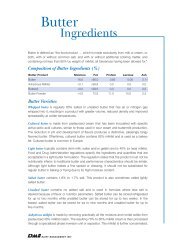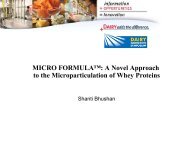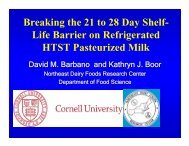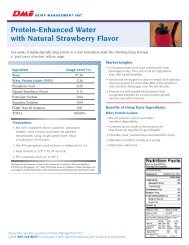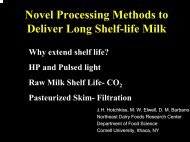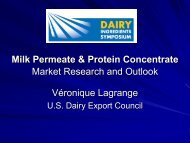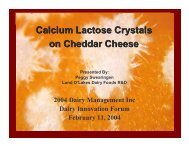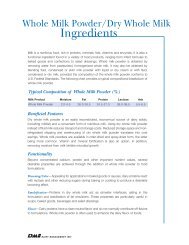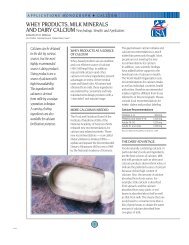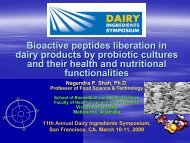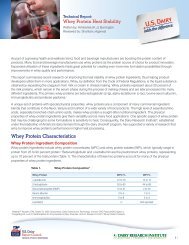Emerging Milk Protein Opportunities - InnovateWithDairy.com
Emerging Milk Protein Opportunities - InnovateWithDairy.com
Emerging Milk Protein Opportunities - InnovateWithDairy.com
Create successful ePaper yourself
Turn your PDF publications into a flip-book with our unique Google optimized e-Paper software.
Fractionating With Charged<br />
UF Membranes<br />
Historically, ultrafiltration (UF) has been used in the dairy<br />
industry to concentrate milk proteins. However, research<br />
indicates that when a charge is added to a UF membrane,<br />
existing UF equipment can be used to fractionate milk proteins.<br />
This means dairy ingredient manufacturers can increase the<br />
return on investment of their membrane systems by producing<br />
higher-value milk protein fractions.<br />
Charged membranes are made by chemically treating<br />
<strong>com</strong>mercially available UF membranes already in use by the<br />
dairy industry. The treatment places a permanent positive charge<br />
on the membrane that will not wash off and provides a stable<br />
boost to the separation power.<br />
Mark Etzel, Ph.D., professor of food science at the University<br />
of Wisconsin-Madison, conducted research on how charged<br />
membranes impact milk protein fractionation. Three protein<br />
solutions were investigated in the test: gly<strong>com</strong>acropeptide (GMP),<br />
beta-lactoglobulin (BLG) and a binary mixture of both GMP and<br />
BLG. The efficacy of fractionation was determined at four levels<br />
of pH, ranging from 3.0 to 7.5, and filtration pressures ranging<br />
from 0.14 to 2.1 bar. Solutions with the same pH conditions were<br />
filtered using uncharged membranes to study the separation<br />
power of the charged membranes to fractionate GMP and BLG.<br />
<strong>Milk</strong> protein fractionation using charged membranes<br />
P 2<br />
PURIFIED GMP<br />
P 1 2<br />
GMP<br />
+<br />
BLG<br />
1<br />
R 2<br />
P 3<br />
3<br />
R 1<br />
R 3 PURIFIED BLG<br />
RECYCLE TO FEED SOLUTION<br />
R1, R2, R3 = retentate of UF membrane, Stages 1, 2 and 3, respectively<br />
P1, P2, P3 = permeate of UF membrane, Stages 1, 2 and 3, respectively<br />
The research found that adding a positive charge to the ultrafiltration<br />
membrane increased the separation power by more than 600<br />
percent. The GMP and BLG were successfully separated using the<br />
charged membrane, but not when using the uncharged membrane.<br />
Charged membranes cleanly fractionate similarly sized proteins<br />
from cheese whey, something that has not been feasible in the past.<br />
An alternative to ion exchange<br />
Additional research is under way to measure whether going through a<br />
series of membranes can increase the purity and yield of milk protein<br />
fractions derived directly from milk. The results to date are encouraging.<br />
“For manufacture of milk protein fractions directly from milk,<br />
charged UF membranes may replace ion exchange resins in some<br />
applications,” Etzel notes. “This change in technology can lower<br />
the cost and improve simplicity of fractionating milk proteins.”<br />
Process Innovation<br />
Offers Strong Market<br />
Potential With Beta-Casein<br />
Innovations in microfiltration now enable dairy ingredient<br />
processors to extract three distinct ingredient streams from<br />
whole milk in a single, integrated process.<br />
Research conducted at the Wisconsin Center for Dairy<br />
Research (WCDR), located at the University of Wisconsin-<br />
Madison, has resulted in a new process (patent applied for)<br />
that yields beta-casein concentrate, whey proteins<br />
and casein, directly from whole milk in a cold process.<br />
The additional isolation of beta-casein provides a<br />
new revenue stream with strong market potential.<br />
In fact, according to the U.S. International Trade<br />
Commission, caseins represent about 30 percent<br />
of all dairy imports.<br />
mimic human breast milk, which has a higher ratio of beta-casein<br />
to other caseins.<br />
Advances in filtration<br />
John Lucey, Ph.D., professor of food science at the University of<br />
Wisconsin-Madison, and Karen Smith, Ph.D., dairy processing<br />
technologist at the WCDR, report that new advances in microfiltration<br />
have greatly enhanced the <strong>com</strong>mercial prospects for isolating the<br />
three streams from milk.<br />
“Ceramic microfiltration membrane filtration systems have been<br />
used for certain specialized applications in the dairy industry,”<br />
Lucey says. “We now have polymeric membrane systems that<br />
SKIM MILK<br />
COLD<br />
MF<br />
WHOLE MILK<br />
WARM<br />
U.S.-produced beta-casein could take<br />
the place of imported sodium caseinate<br />
for applications that require foaming and<br />
emulsification properties. Infant formula<br />
manufacturers also have shown interest<br />
because beta-casein would enable them<br />
to create formulas that more closely<br />
RETENTATE (CONCENTRATED<br />
CASEIN/BETA-CASEIN DEPLETED)<br />
RETENTATE (BETA-CASEIN)<br />
PERMEATE (BETA-<br />
CASEIN/WHEY PROTEINS)<br />
UF<br />
RETENTATE<br />
(CONCENTRATED CASEIN)<br />
PERMEATE (WHEY PROTEINS)<br />
PERMEATE (WHEY PROTEINS)<br />
Flow diagram for the new<br />
Integrated UW-Madison<br />
<strong>Milk</strong> Fractionation Process<br />
that produces beta-casein<br />
concentrate, whey proteins<br />
and casein directly from<br />
whole or skim milk at cold<br />
or warm temperatures.<br />
6 <strong>Milk</strong> <strong>Protein</strong> <strong>Opportunities</strong>



